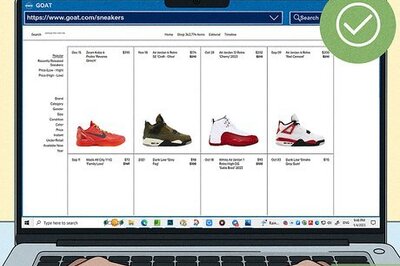
views
What is retinol purging?
Retinol purging is a temporary period of skin irritation caused by retinol use. It’s completely normal to experience skin purging when you first start using retinol, says board-certified dermatologist Dr. Aanand Geria, MD, and it usually looks like acne breakouts, dryness, flaky skin, and redness. This happens because retinol (a topical form of vitamin A) promotes skin cell turnover, which means it removes dead skin cells and encourages new cells to develop more quickly. This brings clogged pores and breakouts to the surface quicker than normal and can leave your skin red, flaky, and sensitive. Dr. Geria says it’s normal to “get a little freaked out in the first few weeks” when you experience breakouts or your skin appears to look worse. He assures you that “it's nothing to worry about,” and it goes away fairly quickly. It’s important to remember that retinol does not cause acne breakouts. Rather, it’s “causing some of the debris to be extruded from the skin” that was already present under the surface, says Dr. Geria.
What does retinol purging look like?
Retinol purging can cause breakouts, dryness, redness, and flaking. During a retinol purge, most people develop some acne where they most commonly get breakouts on their face. This includes small whiteheads, blackheads, pustules, papules, and an uneven skin texture. It’s also normal to experience dryness, flaky and peeling skin, itchiness, redness, and general skin sensitivity. How much your skin purges varies from person to person. It can also depend on the concentration of the retinol you’re using and how often you use it. We’ll provide tips to minimize the symptoms of purging in the sections below. Skin purging is different from experiencing a regular acne breakout or an allergic reaction. We’ll explain the differences in the sections below, as well as when you might want to stop using retinol and talk to your doctor or dermatologist.
How long does retinol purging last?
Retinol purging usually lasts for 3 to 6 weeks. During the first few weeks of using retinol regularly, you may develop acne, flaky skin, uneven texture, and redness. Dr. Geria says it usually “takes about one month to start seeing results” from retinol and for the purging to start to subside. He asserts that it’s important to keep up your routine even when you experience purging, as it can take “about three months to see the full effect” of retinol and get clearer, smoother, brighter, and plumper skin. The general stages of retinol purging are: Week 1-2: You start to experience new breakouts, and your skin may appear red and irritated. You’ll likely experience dryness and skin peeling or flaking, too. Week 2-4: You’re still getting breakouts, but you’re seeing fewer new pimples, and the previous spots are healing. Your skin may feel rougher than normal while the redness, irritation, and dryness are decreasing. Week 4-6: Fewer acne spots are developing, and your skin is starting to clear up, get smoother, and appear brighter. Redness, dryness, and irritation should be very minimal or completely gone. Retinol purging only lasts as long as it takes for your skin to get used to the product. Once your skin has adjusted, you shouldn’t experience any more purging symptoms unless you increase the concentration of retinol or start applying it again after not using it for a while. If the breakouts and irritation still aren’t getting better after 6 weeks, it may be a sign that the retinol product or concentration isn’t right for you. Stop using the retinol and talk to your dermatologist or health care provider to see if a different product might be better for your skin.
How to Treat Purging Symptoms
Start with a low concentration, over-the-counter retinol product. Retinol comes in all different forms and concentrations, from over-the-counter retinols that are less potent to prescription-only retinoids that are much stronger. Strong retinol products can cause more breakouts and more intense irritation, so board-certified dermatologist Dr. Kaveri Karhade, MD, suggests “starting with an over-the-counter version” of retinol to “slowly get your skin used to it.” Once the breakouts and irritation go away, Dr. Karhade says you can switch to a stronger over-the-counter retinol, or talk to your dermatologist or health care provider about getting a prescription-strength retinoid.
Apply a small amount of retinol at night, once or twice a week. Retinol is a powerful skin care product, so you only need a small amount to work its magic. Dr. Karhade recommends applying a pea-sized amount to your entire face at night. To help your skin adjust to it and prevent irritation, start by applying it once or twice a week. Retinol can make your skin more sensitive to the sun, so most dermatologists recommend applying it at night. As a plus, this gives the retinol plenty of time to soak into your skin and work its full effects.
Moisturize your skin after applying retinol. To lessen dryness, flakiness, and irritation, Dr. Karhade says to follow up retinol with a moisturizer. Simply use a gentle, non-comedogenic, and fragrance-free moisturizer to help soothe your skin and prevent clogged pores. There are different opinions on when exactly to apply moisturizer. Some dermatologists suggest applying it directly after retinol, 30 minutes after, or even before you put on retinol. Always follow your dermatologist’s or health care provider’s instructions. If your skin is very dry or irritated, you may find it helpful to apply a thin layer of moisturizer before and after you put on retinol.
Slowly build up to using retinol every night or every other night. Each week, add an additional night when you apply the retinol. For instance, you might apply it one night a week for the first week, two nights for the second week, and 3 to 4 nights for the third week. By the fourth to fifth week, aim to apply the retinol every other night or every night. Pay close attention to how your skin is responding to the retinol. If your skin is very irritated or dry after applying it every other night for a week, drop down to applying it twice per week.
Apply sunscreen every day. Because retinol can make your skin more sensitive to the sun, it’s important to wear an SPF 30 sunscreen each day. Plus, board-certified dermatologist Dr. R. Sonia Batra, MD, MSc, MPH, says sunscreen is an important component of a good skin care routine. It protects your skin from sun damage (dark spots, wrinkles) to keep it looking plump and youthful.
Avoid using exfoliants and harsh products as your skin adjusts. Keep your skin care routine simple when you first start using retinol, and simply wash your face with a gentle cleanser. While you may want to treat retinol purge breakouts with other chemical exfoliants, like salicylic acid, or facial scrubs, these products can increase irritation, dryness, and redness while your skin is adjusting to retinol. Once your skin adjusts to retinol, you can slowly combine it with other products like salicylic acid or glycolic acid. To combine them safely, apply them on opposite days, or retinol at night and the other product in the morning.
Differences Between Purging & Other Skin Conditions
Skin purging vs acne breakouts During a retinol purge, you often experience breakouts where you’re applying the retinol and where you normally get acne, like around your T-zone. The spots are generally smaller and less deep than an acne breakout, and most importantly, the breakouts are temporary and go away after several weeks. If you’re experiencing an acne breakout, you may get acne all over (face, neck, back), the spots often appear larger and more inflamed, and it may take longer for them to heal. The causes are also different. Retinol does not cause acne to form, and instead, it brings existing impurities to the surface. Acne breakouts often develop from stress, oily skin care products, air pollution, and some foods (like skim milk).
Skin purging vs allergic reactions It’s normal for retinol to cause some breakouts, redness, and irritation during the first few weeks of using it. However, if your breakouts are appearing where you don’t typically get acne, you experience swelling, or the redness and irritation do not go away after several weeks, it’s possible that you’re allergic to the product. Stop using the retinol and talk to your dermatologist or health care provider about next steps.
When to See a Doctor
Talk to your doctor if purging symptoms last longer than 6 weeks. If your skin isn’t improving after 6 weeks and you’re still noticing lots of breakouts, irritation, redness, or swelling, stop using the retinol and visit your dermatologist or health care provider. It’s possible that the retinol product isn’t reacting well with your skin, or you’re having an allergic reaction. Your doctor might suggest using a different concentration of retinol, a different retinol product, or using a different skin care treatment altogether.


















Comments
0 comment